Many gardeners expend all their energy on their spring- and summer-blooming garden, then feel as exhausted as their plants by September. You can overcome these autumn blahs by adding one of the many fall-blooming asters. Not only will you energize this season's flower garden, you'll enjoy the aster's sparkling blossoms for years to come with a small amount of care.
(Editor's Note: This article was originally published on September 21, 2009. Your comments are welcome, but please be aware that authors of previously published articles may not be able to respond to your questions.)
Autumn Aster Facts
• strong bloomers until season's end
• available in all shapes and sizes from short and low-mounding to tall and willowy
• wide array of colors including white, pink, red, lavender, mauve, blue, purple
• charming daisy-like flowers attractive to butterflies
• require sun, good air circulation and moist soil
• excellent cut flowers
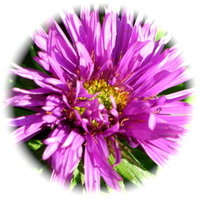
Introducing the Aster
Although most people think of asters as fall flowers, you can actually have asters blooming in your garden from spring until the end of the season. This article will concentrate on some of the autumn-blooming varieties available.
Asters have a daisy-like flower, and in fact are often mistaken for daisies. Like other daisy types, the aster bloom is actually several flowers which together form a flower-like structure. What we think of as the aster’s petals are actually ray flowers, which radiate from a tight central button of disk flowers.
While the ray flowers of the aster can be white, blue, purple, pink or red, the central disk flowers are always golden or orange in color. The shape of the flower led Swedish botanist and taxonomist Linnaeus to name the plant “aster”, from “astron”, the ancient Greek word meaning “star”.
Asters are tough--most are hardy to zone 4, and a few to zone 3. Asters are members of Asteraceae, the second largest family of flowering plants, and most are indigenous to North America, where they are denizens of woodland, field and roadside. Hybridization began in the early 1900s, as breeders took these colorful but rangy wildflowers and created more compact varieties with larger flowers. See Kathleen M. Tenpas' article Native Asters in South Western New York for more information about native asters.
In Britain, the aster became known as the “Michaelmas Daisy” because its bloom coincided with the September 29 feast of the archangel St. Michael. Gertrude Jekyll, the English planter known for her painterly approach to gardening, was quite fond of asters:
“At this time of the year, when the flower borders, if not quite done for, are at least at their last stage before final dissolution, it is a joy to come upon a well-planted border of the perennial asters, with their clear fresh colouring all the more accentuated by contrast with the general sombre rustiness of the greater part of the neighbouring vegetation.” [1]
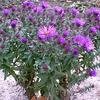
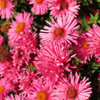
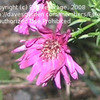
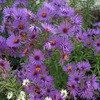
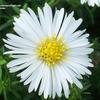
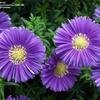
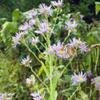 New England Aster
New England Aster
'Purple Dome'
New England Aster
'Alma Potschke'
New England Aster
'September Ruby'
New England Aster
'Hella Lacy'
New York Aster
'Puff White'
New York Aster
'Magic Dark Blue'
Tatarian Aster
'Jin Dai'
 Autumn Asters To Try
Autumn Asters To TryThe best-known autumn aster is
Aster novae-angliae, the New England aster. Two classic cultivars are ‘Alma Potschke’, with brilliant rose-pink flowers on three-foot stems, and the 18 to 24 inch ‘Purple Dome’ which has bright purple semi-double flowers.
Similar to the New England aster, but generally shorter, is
A. novi-belgii, or the New York aster (the Latin name means New Belgium, an early name for New York). The stems of the New York aster are more slender than those of the New England types, and have smooth rather than hairy leaves. Some cultivars for the front of the border are ‘Jenny’ which is red, 'Puff White', a clear white, and the lavender-blue ‘Professor Kippenberg’. All of these dwarfs are mounding in form and about 12 to 16 inches high.
In
The Well-Tended Perennial Garden, Tracy DiSabato-Aust states that her favorite aster is the lavender-flowering
A. oblongifolius var. angustatus ‘Raydon’s Favorite’. [2] This year I decided to try it in my own garden, heeding her advice to cut it back by half in early summer for height control. Though my Raydon’s aster is still a few weeks away from blooming, I am already impressed with its foliage, which is bright green, untroubled by pests or disease, and for a big plant, pleasingly delicate.
One other late-season aster of note hails from Asia.
A. tataricus ‘Jin Dai’ is a 3-foot by 3-foot spreading mass of lavender-blue blooms in October-November. ‘Jin Dai’ is also recommended by DiSabato-Aust as a self-supporting and easy to grow cultivar.
 Aster Culture
Aster CultureAster cultivars do require a little care to look their best. Powdery mildew is a problem for some asters, though newer varieties have been bred to be mildew-resistant. Asters like a well-drained soil rich in organic matter, and do best with full sun or only light shade. During their long growing season, their soil should not be allowed to become overly dry. It seems counterintuitive, but dry conditions actually encourage powdery mildew to attack the plant. Avoid overhead watering and use drip irrigation to help keep the foliage dry and disease-free. The aster evolved in sunny, exposed spots, so good air circulation is important. The tallest asters require staking, otherwise once they come into bloom they are likely to flop over their garden neighbors. You can avoid the need for staking by pinching back asters in the same way you would mums. Pinching back once when plants are about 6 inches high, then again about a month later (but no later than early summer) will yield shorter and more compact plants. Although asters can be prodigious self-seeders, the hybrids do not breed true to type.
If asters have a fault, it is their sheer exuberance. Left to themselves, asters tend to spread and die in the center. You can replant the vigorous shoots from the outside of the clumps, discarding the center. The best time to divide fall-blooming asters is in the spring. Plan to divide your fast-growing asters every other year. It’s a small price to pay for a bounty of blooms at the end of the gardening season.
 How to Use Asters
How to Use Asters
The typically cool blue and violet tones of the fall asters provide a vivid contrast to autumn's warm gold and red colors. Consider partnering asters with grasses, autumn-blooming allium, mums, fall sedums, goldenrods and Japanese anemones. Asters also make lovely cut flowers. Their clouds of star-like blossoms soften and fill out the spaces between larger flowers in a vase, imparting informality and friendly charm to any arrangement. Asters are a must for any Butterfly Garden, as they are a favorite source of nectar for the Painted Lady, Monarch, and other butterflies.
Footnotes:
[1] The Unknown Gertrude Jekyll, selected and edited by Martin Wood, Frances Lincoln Ltd., ISBN 978-0711226111.
[2] The Well-Tended Perennial Garden, Tracy DiSabato-Aust, Timber Press, ISBN 978-0881924145.
Photo credits: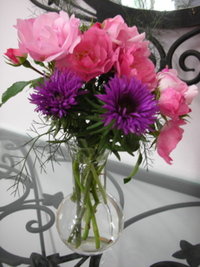
Square thumbnail photo: Raydon's Favorite by kimberlyfaye
Dave's Garden photos by: pinky100 ('Purple Dome'); Aphthona ('Alma Potschke'); Kell ('September Ruby'); poppysue ('Hella Lacy'); TuttiFrutti ('Puff White' and 'Magic Dark Blue'); mgarr ('Jin Dai')
Other photos of 'Purple Dome' by the author













 New England Aster
New England Aster Autumn Asters To Try
Autumn Asters To Try Aster Culture
Aster Culture
